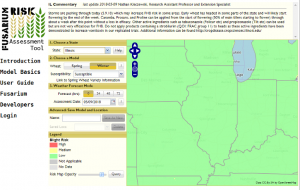Now that we are nearly wrapped up with harvest, individuals likely have questions about grain storage and grain quality. One item that sometimes can be confusing is the issue of mycotoxins. After all, the grain is out of the field, so that’s the end of it, right? Unfortunately not, and storing grain under the wrong conditions can actually result in grain with increased levels of mycotoxins. This unfortunately means that your IPM strategies for disease management in your crops also needs to extend to storage (apologies for the bad news).
What are mycotoxins? These are what are known as secondary metabolites (compounds that might not appear to have a role in the growth or reproduction of the fungus), that are produced by some, but not all fungi. In some cases, the role of a toxin is immediately evident, for example a function can be to kill portions of the plant tissue, providing more accessible nutrients for use by the pathogen. In other cases, the mycotoxin might circumvent plant “alarm systems.” In other situations these compounds can have a defensive role, potentially limiting the ability of other microbes or fungi to colonize tissues and resources, or protecting the fungus from consumption by other organisms. Examples of toxins having this sort of role in other systems include secondary metabolites in certain trees deterring feeding by rabbits, insects that are toxic or deadly when fed on by predators (e.g. monarch butterflies), plants with seeds containing toxins to limit consumption (e.g. cyanide in apple seeds), and even fungi that contain mycotoxins so potent eating a small portion of a single mushroom can cause death (e.g. Death caps and Destroying Angels). In field crops the role of some of these toxins is unknown, but what we do know is that some can make humans and livestock very sick (Click here for more information). However, the fungus needs to be active to produce toxins, and may only do so under certain circumstances. If it is too hot/cold, wet/dry, toxins may not accumulate to a significant degree.
One of the management strategies for limiting the impact of mycotoxins is a timely harvest. A timely harvest reduces the amount of time the grain is in the field and available for toxin-producing fungi to colonize and grow in/on tissues. Next, your grain storage areas should be weather proof and cleaned prior to storage. Ensure that grain is dried to a moisture content of at least 15% moisture. Why is moisture important? Remember, in order for fungi to produce toxins they need to be active and growing. Fungi need a certain amount of moisture to grow, and levels less than 15% often inhibit fungal growth and therefore mycotoxin production. Another factor to consider is the temperature of grain in storage. Most fungi grow well when temperatures are warm or even hot, and grain in the bin will continue to respire and produce heat. Maintaining bin temperatures at 55F can further reduce fungal growth and potential mycotoxin damage. There are other practices that can reduce specific mycotoxin levels in your bin. For example, screening scabby wheat grain or treating aflatoxin contaminated grain with anhydrous ammonia.
Although it is true that mycotoxin management starts in the field, remember that there are actions you can take to ensure that these metabolites do not increase in levels in stored grains. Rather it is the fungi that produce them that remain active that can potentially increase toxin accumulation. MAke sure storage is part of your integrated disease management plan for your crops.
Want to learn more? Check out this primary literature.
Magan N, Aldred D, Mylona K, Lambert RJ. 2010. Limiting mycotoxins in stored wheat. Food Addit Contam Part A Chem Anal Control Expo Risk Assess. 27(5):644-50. doi: 10.1080/19440040903514523. PMID: 20455159.
Miller, J. D. 1995. Fungi and mycotoxins in grain: Implications for stored product research. Journal of Stored Products Research. 31:1-16.
Mannaa, M. and Kim, K.D., 2017. Influence of temperature and water activity on deleterious fungi and mycotoxin production during grain storage. Mycobiology, 45(4), pp.240-254.
Magan, Naresh, Russell Hope, Victoria Cairns, and David Aldred. “Post-harvest fungal ecology: impact of fungal growth and mycotoxin accumulation in stored grain.” In Epidemiology of mycotoxin producing fungi, pp. 723-730. Springer, Dordrecht, 2003.
Chulze, S.N., 2010. Strategies to reduce mycotoxin levels in maize during storage: a review. Food Additives and Contaminants, 27(5), pp.651-657.
No

